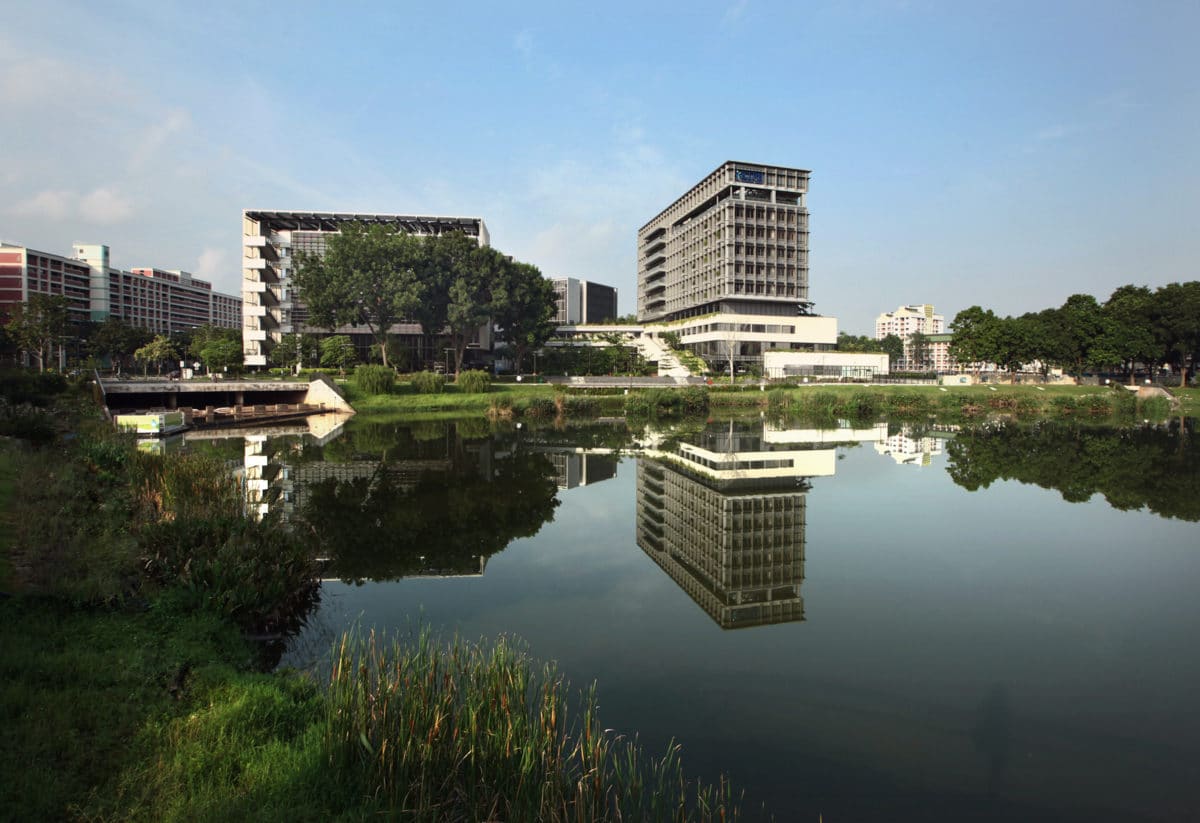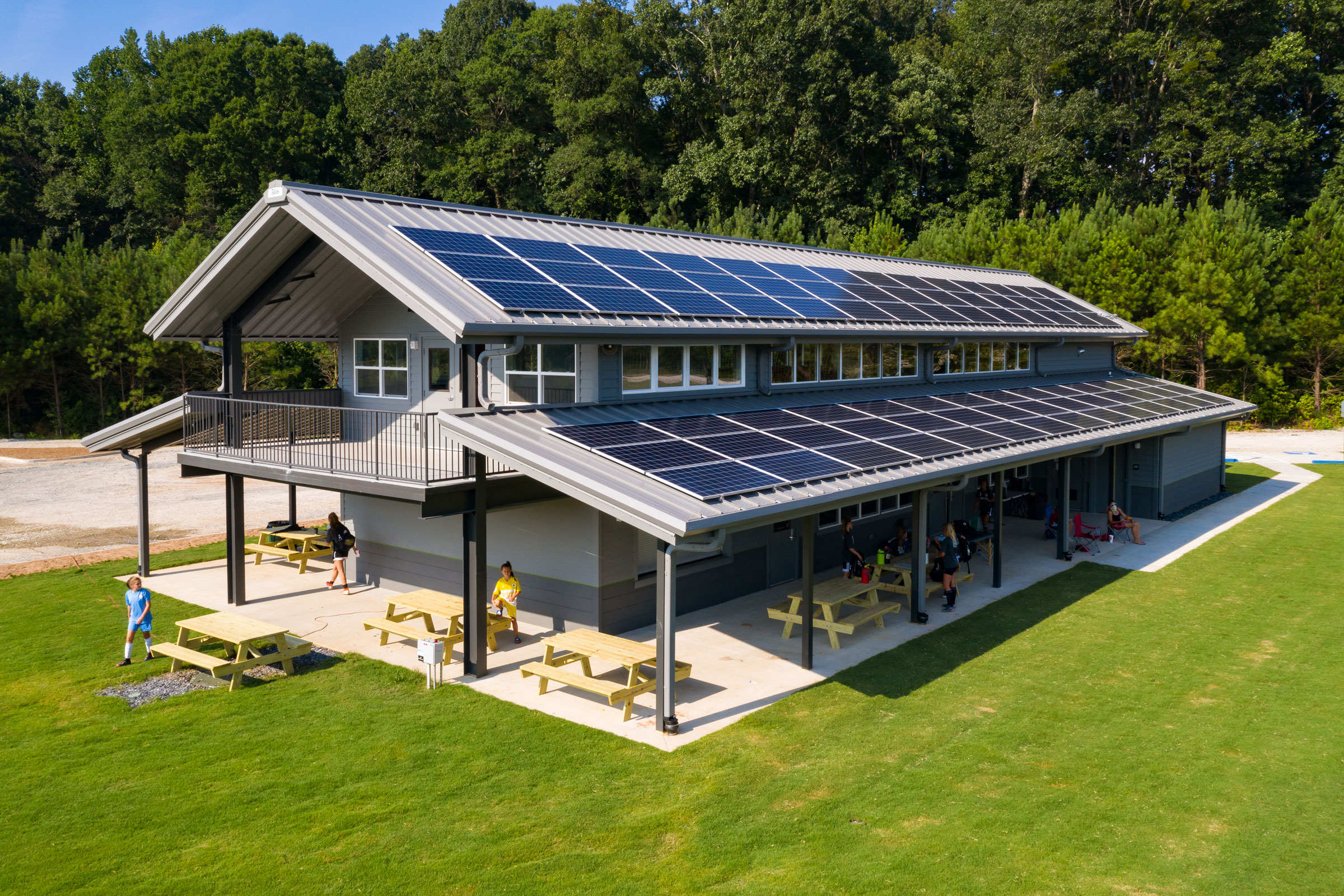Story at a glance:
- Rainwater harvesting is an age-old practice that describes the process of intentionally collecting and storing rainwater for future use.
- Modern rainwater harvesting systems may be used for irrigation purposes or even as a primary/secondary water supply for a building.
- Direct-pumped, indirect-pumped, and indirect-gravity rainwater harvesting systems are among the most popular for residential and commercial buildings.
Rainwater harvesting, also referred to as rainwater catchment or collection, has been practiced by many different peoples throughout history as a means of storing excess water for use at a later date. Indeed, archaeological evidence from Southwest Asia suggests rainwater was being harvested in large quantities as early as the Neolithic Age (10,000 to 4,500 BCE).
Unsurprisingly these emerging rainwater collection technologies coincide with the advent and proliferation of large-scale agricultural centers, many of which—particularly those located in hotter, drier regions—relied on the supplementary irrigation made possible by large rainwater storage cisterns.
Today rainwater is collected, stored, and reused around the world for a variety of purposes, most notably watering gardens, lawns, crops, and the like. But as climate change exacerbates water scarcity around the globe, more and more architects, engineers, and urban planners are incorporating rainwater harvesting into the plumbing systems of the buildings they design, increasing both their water independence and water efficiency.
What is Rainwater Harvesting?

The Punta House in Mexico City features a rainwater harvesting system that provides the homeowners with six months of water autonomy. Photo by Jaime Navarro
In the fundamental sense, rainwater harvesting describes the process by which rainwater runoff is intentionally collected from an impervious structure or surface, with the most common being both flat and angled rooftops. During rainstorms, water is channeled into a building’s gutters or through a drainage system, funneled into downspouts, and redirected or emptied into some sort of storage vessel, such as a barrel, cistern, or even a retention pond.
Depending on the rainwater’s intended use and the harvesting system’s level of sophistication, the collected water may be used as is—which is typically the case if it’s being used for landscape irrigation—or it may go through a treatment and/or purification process, in which case it may be used for plumbing purposes, such as flushing toilets.
Main Components of a Rainwater Harvesting System
As we’ll discover later in this article, there are a few different types of rainwater harvesting systems, many of which feature unique elements—in general, however, the following components are present in most rainwater harvesting systems:
- Catchment. Describes the actual surface which directly receives rainfall, such as a roof, terrace, courtyard, etc.
- Gutter/Channel guards. Mesh or screen that prevents large debris, such as leaves, from entering a building’s gutters or water channels.
- Gutters. Channels positioned around the edge of a building’s sloped roof (flat-topped buildings typically do not have gutters) that collect and transport rainwater laterally.
- Conduits/Downspouts. Pipes or drains that transport water from a gutter or catchment area to the main harvesting system.
- First-flush device. A valve that prevents runoff from the first spell of rain from entering the harvesting system, as this first spell typically carries a higher concentration of pollutants from both the air and catchment surface.
- Filter. A device used to filter out smaller debris and media (such as dirt, fibers, sand, etc.) before it enters the rainwater storage tank.
- Storage tank. The container or cistern that actually stores collected rainwater for further use.
Depending on what the collected water is being used for, a rainwater harvesting system may also include a treatment and/or purification system, which use either chemicals or UV light to ensure that the water is safe for human consumption.
Benefits of Rainwater Harvesting

In 2022 Kingspan harvested 26.1 million liters of rainwater, progressing toward a target of 100 million liters of rainwater annually harvested by 2030. Photo courtesy of Kingspan Light + Air
While the immediate benefit of rainwater harvesting—that is, the conservation element—may seem obvious, there are a range of additional benefits as well, such as:
Reduced Stormwater Runoff & Urban Flooding
As the severity and frequency of high-intensity storms increases alongside accelerated anthropogenic climate change, so too does the risk of urban flooding. Due to the prolific distribution of impermeable paved surfaces in urban spaces, rainwater isn’t able to soak into the soil but instead sits atop roadways and causes sewers to overflow.
Building-scale rainwater harvesting systems, however, can drastically reduce the amount of stormwater runoff by allowing buildings to collect and store thousands of gallons of precipitation which would otherwise flow into the surrounding streets.
Independent & Supplementary Water Supply
Another advantage of onsite rainwater harvesting is that it acts as an independent water reservoir, reducing dependency on the public water supply or imported water. This can be especially useful during the summer months, as it reduces peak demand and saves treated, potable water for more important uses.
In rural areas where buildings rely on well-water, rainwater harvesting systems provide an additional or supplementary source of water, reducing the risk of depleting vital underground aquifers and improving overall water security.
Improved Drought Resilience
As it stands, approximately 55 million people are affected by droughts each year, with that number expected to steadily increase as the planet continues to warm, according to the World Health Organization.
Unsurprisingly, droughts are some of the single most devastating hazards to humans, livestock, and crops around the world, especially for those living in naturally dry, arid regions where water is already scarce. Communities and cities commonly affected by droughts can, however, improve their resiliency by installing large-scale rainwater harvesting systems that allow them to set aside and store water for use during extended dry periods.
Healthier for Plants
Due to the fact that rainwater lacks the chemicals—such as fluoride and chloramine—added to most treated water, it is incredibly useful for irrigation purposes and ultimately produces healthier plants and soil.
Economical & Efficient

Underneath this city plaza, a 400,000-gallon cistern collects rainwater for reuse, reducing demand on the public water supply. Photo courtesy of Noll & Tam Architects
In their most basic form, rainwater harvesting systems are extremely economical as they provide a free, supplementary, low-to-no energy water source that can be used instead of municipal or well water, resulting in lower utility bills.
Larger and more complex rainwater harvesting systems, on the other hand, can be expensive to install, but ultimately help reduce operating costs in the long term. Highly-integrated rainwater systems which supply water to appliances and plumbing fixtures can help reduce a building’s water bill by 40 to 50%.
Of course, the economic benefits of rainwater harvesting extends beyond the individual building, as widespread rainwater harvesting ultimately reduces demand for municipal water—which must be treated and pumped—subsequently saving the municipality energy and reducing water service costs. What’s more, rainwater harvesting can also reduce a municipality’s long-term water development needs, allowing them to use existing infrastructure investments more efficiently.
Types of Rainwater Harvesting Systems

Rainwater from the roof is collected in an underground cistern and feeds the automatic irrigation system for the plants on the façade and the garden at this Snohetta-designed ASI Reisen. Photo by Christian Flatscher
While the notion of rainwater harvesting typically brings to mind an image of the humble rain barrel, the truth is that a variety of different types of rainwater harvesting systems exist, of which vary considerably in scale, application, and complexity.
Rainwater Barrels & Basins
As the most basic—and probably the most recognizable—form of rainwater harvesting, rainwater barrels, basins, and tanks are essentially just outdoor storage units designed to collect water as it falls from the sky. In antiquity, these typically took the form of uncovered stone basins, troughs, or clay containers and were filled through a combination of direct rainfall and downspout flow.
Wooden barrels have also been used to collect rainwater in many parts of the world, particularly in Europe and North America, where they are still used in some places today.
In modernity, rainwater barrels look much like their predecessors, but are typically made from PVC. Most feature some sort of mesh screen to block debris and are positioned underneath a building’s downspout, where they gradually fill with water during rainstorms. Water may be removed from the barrel via a spigot at the base of the container or by removing the cover and submerging a bucket directly in the collected rainwater.
On their own—that is, unconnected to any sort of plumbing—rainwater barrels are incredibly easy to set up and are used almost exclusively for low-scale household gardening and/or irrigation.
Gravity-Only
As one of the most energy-efficient types of rainwater harvesting, gravity-only systems function purely through gravity and require no energy to operate, as there is no pump involved. In order for a gravity-only system to work, however, rainwater can only be collected in containers that are located below gutter-level and above the outlets they feed into.
Indirect-Gravity

This home includes a solar array on the roof, a rainwater harvesting system, radiant floor heating, and a geothermal heating and cooling system. Photo courtesy of REHAU
Rainwater harvesting systems using indirect gravity operate similarly to gravity-only systems, but rely on a pump to first transfer the collected water to a high-level header tank, where it is then allowed to free-flow by way of gravity alone. In this regard, indirect gravity systems are more versatile than gravity-only systems, as the main rainwater collection container does not need to be in an elevated position.
Direct-Pumped
Alternatively, rainwater may be harvested using a direct-pumped system, or that which uses pumps to transfer collected rainwater from an underground storage tank directly to the point of use. Direct-pumped systems are heavily dependent on electricity and are typically used in residential settings; they may use either a submersible or suction pump, with the former being the most efficient and most popular.
- Submersible. Direct-pumped submersible systems feature a pump located within an underground tank that, when in use, pumps water out and directly to appliances and WCs that require it.
- Suction. Rather than the pump being located inside the underground storage tank, direct-pumped suction systems feature a pump located in a control unit within the building; this pump sucks water from the tank and delivers it to those connected outlets.
Indirect-Pumped
An indirect-pumped rainwater harvesting system works similarly to the aforementioned indirect-gravity system in that water is pumped from the main rainwater storage tank to an internal secondary tank before being used by appliances.
Unlike the indirect-gravity system, however, an indirect-pumped system can be located at any level in a building as it does not depend on gravity to feed the outlets but instead uses a booster pump to pressurize the water and send it through the pipes.
Retention Ponds

Retention ponds can act as a form of rainwater harvesting and may be used to recharge groundwater, reduce flooding, and effectively manage runoff. Rendering courtesy of the International Living Future Institute
Finally, rainwater may be stored in retention ponds—or man-made ponds featuring a permanent pool of water surrounded by a perimeter of vegetation made up of native grasses, shrubs, and wetland plants. These ponds are designed so as to effectively manage stormwater runoff, reduce erosion, and mitigate the risk of flooding, but also serve an aesthetic purpose as well.
Retention ponds are considered to be a form of rainwater harvesting in that the water they store may be used for irrigation purposes or as a means of increasing groundwater recharge.
In the Field: Examples of Rainwater Harvesting
Now that we’ve covered the what and how of rainwater harvesting, let’s take a look at a few projects that incorporate rainwater catchment and re-use systems.
HMTX World Headquarters

HMTX Industries’ new world headquarters is set to become Connecticut’s greenest building when it opens in Norwalk in 2022. Photo courtesy of HMTX Industries
Located in Norwalk, Connecticut and designed by McLennan Design, the LBC-certified HMTX World Headquarters is an inspiring example of how both regenerative architecture and rainwater harvesting can be incorporated into the design of commercial buildings.
Designed so as to have a minimal—and even positive—environmental impact, HMTX World Headquarters makes use of a variety of conservation techniques, not least among them rainwater harvesting. A 5,000 gallon underground rainwater storage tank provides treated gray-water to the facility’s flush fixtures, utilities, and irrigation, while three separate rain gardens help to naturally treat stormwater and improve the site’s water retention capacity.
While not exactly a conventional method, rain gardens are nevertheless considered a valid approach to rainwater harvesting, as well as a means of reducing stormwater runoff and soil erosion. HMTX’s rain gardens also provide diverse ecosystems for birds, bees, butterflies, and other insects.
Some rainwater is also retained via the building’s 1,700-square foot green roof, which, like the rain gardens, serves to reduce runoff and foster biodiversity.
Georgia Sports Park Pavilion

Georgia Sports Park Pavilion by Lord Aeck Sargent. Photo by Iran Watson Photo
Equipped with a classroom, team rooms, a concession stand, office space, restrooms, and shower facilities, the 6,000-square foot Georgia Sport Park Pavilion in East Point, Georgia showcases how recreational spaces may utilize and benefit from the addition of rainwater harvesting systems.
Designed by the Lord Aeck Sargent (LAS) architecture firm for the Concorde Fire Soccer Club, the Georgia Sport Park Pavilion boasts a 1,800-gallon underground storage tank fed by rainwater harvested via the roof, whose exterior downspouts connect to an underground piping system.
The collected water system was designed and installed by Georgia Water Tanks and uses UV-C light to treat the harvested rainwater. “UVGI devices can produce strong enough UV-C light in circulating water systems to make them inhospitable environments to microorganisms such as bacteria, viruses, molds, and other pathogens,” Rick Bizot, architect with LAS, previously wrote for gb&d.
Once treated, the rainwater is run through a pressure system to provide enough quantity to operate the pavilion’s water closets and flush toilets. In addition to harvesting rainwater, the Georgia Sport Park Pavilion utilizes low-flow toilet fixtures, waterless urinals, push-button low-flow showerheads, and push-button low-flow faucets to reduce its potable water consumption by approximately 85%.
Rain Harvest Home

The Rain Harvest Home project is made up of three buildings that each collect rainwater to integrate with an above- and below-ground reservoir system. Photo by Jaime Navarro
Designed by Robert Hutchison Architecture (RHA) in collaboration with JSa Arquitectura, the aptly-named Rain Harvest Home—or Casa Cosecha de Lluvia—in Temascaltepec, Mexico is a leading example of how effectively rainwater harvesting may be employed in residential settings.
Located in the mountains south of Valle Bravo, the self-sustaining, off-grid Rain Harvest Home encompasses three structures: a house, studio, and detached bathhouse. Due to the region’s extremely wet summers and very dry winters, effective water management was an integral component of the project as a whole—but rather than pump water in from distant watersheds, RHA decided to prioritize rainwater harvesting to fulfill the project’s water use requirements.
All three of the buildings feature rainwater harvesting systems that connect to a central reservoir, where the water is then treated and stored for future use; in this manner, the Rain Harvest Home is able to rely on rainwater for 100% of its water year-round. A chemical-free blackwater treatment system treats all of the wastewater produced onsite, after which it is returned to the site’s water cycle and reused to flush toilets and irrigate the landscape.
“It’s a big self-contained cycle, but I think the most important thing we did was just not to treat it as a system but to treat it as an experience, really thinking about how rainwater could be a way of living on the site,” Robert Hutchison, founder and CEO of RHA, previously told gb&d. “It’s not just a metric; it’s about experiencing and being a part of the site. Because when it rains for six months, to be in the bathhouse when it’s raining is a pretty visceral experience.”




